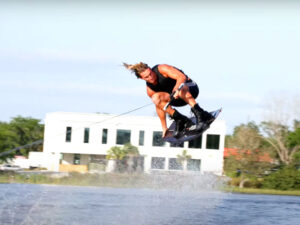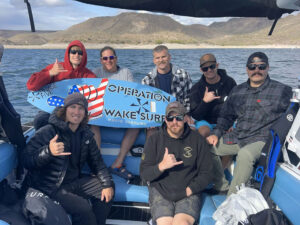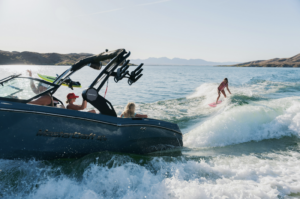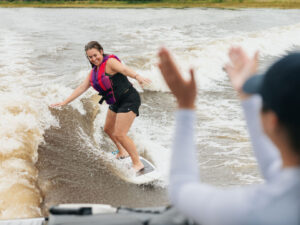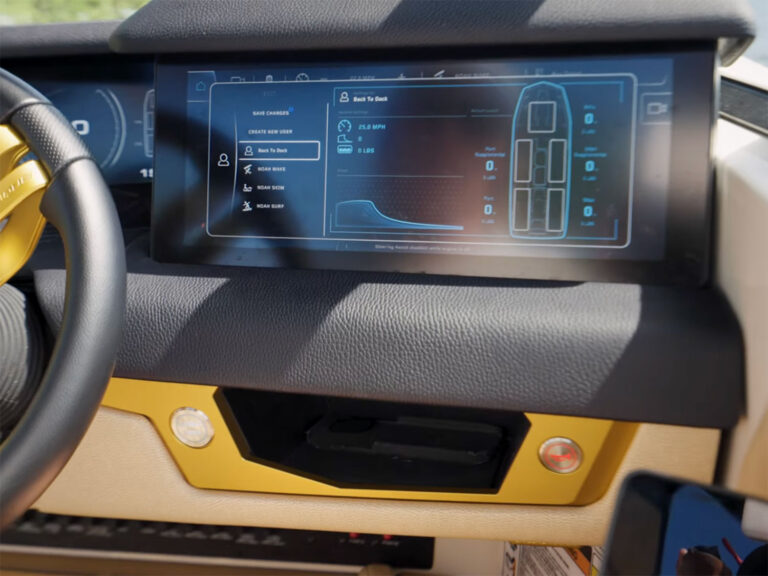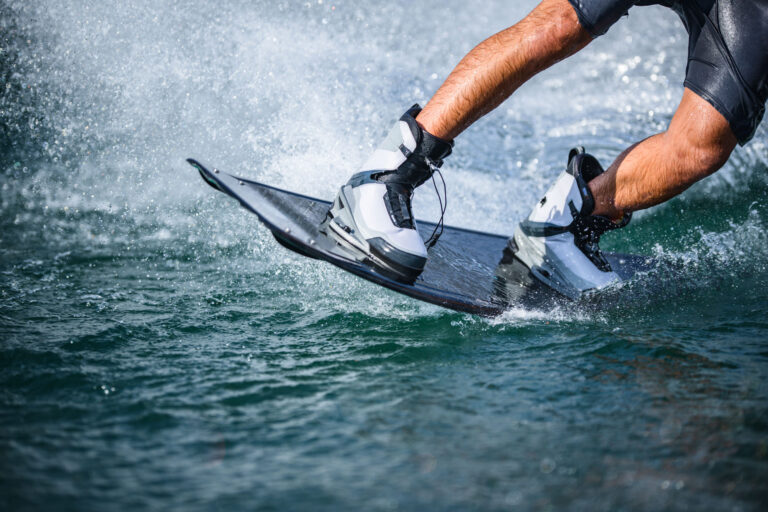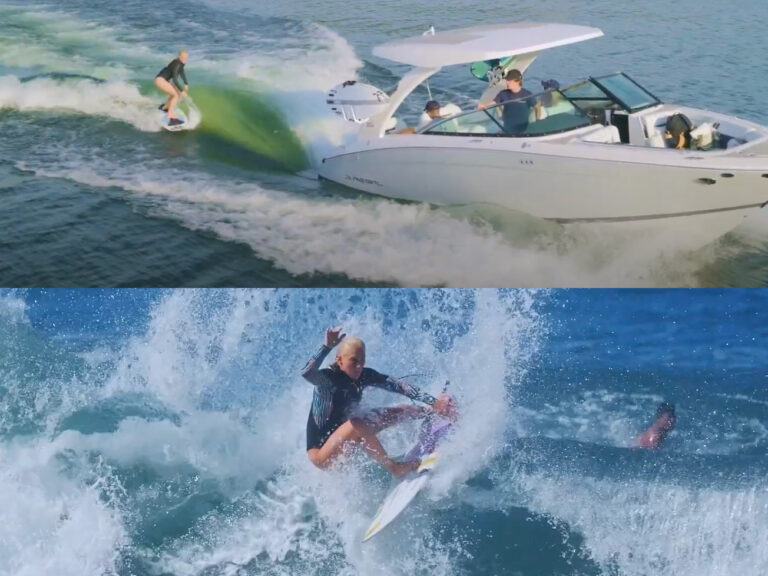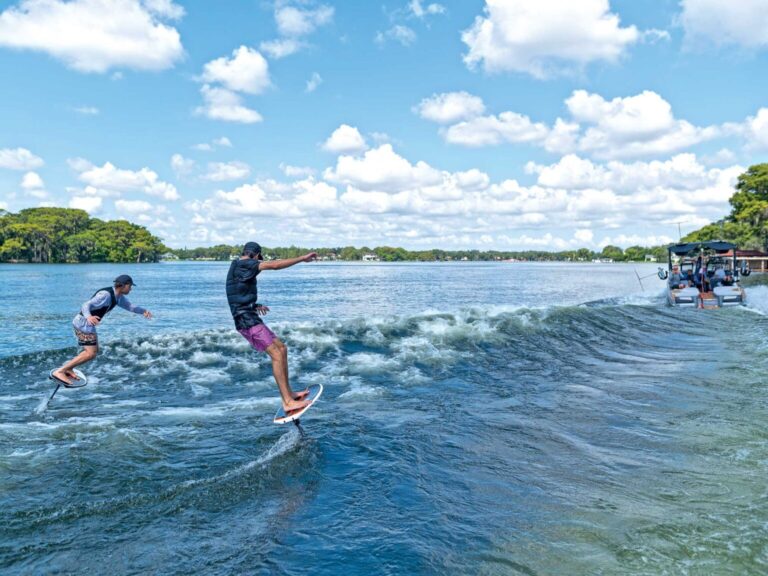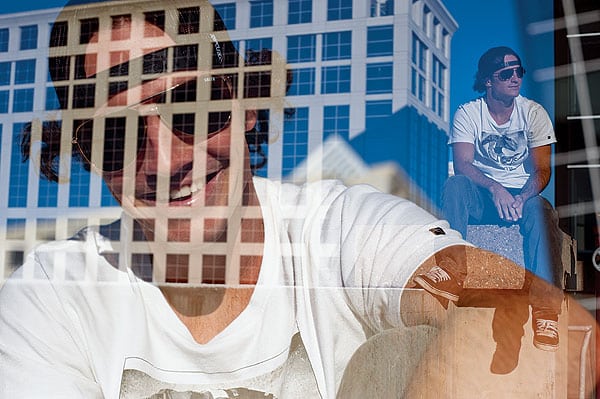
Words: Kevco | Photos: Jason Lee
Although we think Dean Smith is one of the most stylish riders of all time, his balls-to-the-wall approach is tough to get consistent in contests. But no one really considers that a negative trait. In fact, anyone who sees him ride in person will agree he is one of the most impactful riders on the water today. Armed with several moves that are truly his own, including the sickest stalefish backside 360 you’ve ever seen, Dean has been on our radar for quite some time.
It’s hard to imagine a long-term career going as big as Dean does. It’s like eating bacon at every meal, you just don’t do it. But Dean has that perfect wakeboarding frame we are all jealous of — 5 feet 7 inches, 157 pounds and shredded. For those who think his Worlds run was a fluke — time will tell. But on Aug. 22, we saw him go bigger than everyone and grab everything. He is unique, original and has more fun than anyone else. In our eyes, that is the perfect definition of a World champion.
Your style resembles more of a free-rider than a contest rider, but you’re very involved in contests and the format, etc. Why is that?
I’ve always believed contests hold a very important place. They are the basis for which we can become “professional” wakeboarders. Besides, competitions are a great way to get in touch with fans and be involved in the industry.
Why do you choose to ride balls-out in contests when most riders are more conservative?
I don’t really think about it. It’s just how I ride, so why change it? It would be more difficult for me to change my riding style than to keep my balls on the ban saw in contests. Inevitably, it means I fall a lot, and it can be quite comical. I remember Erik Ruck describing a ride I had at the 2006 Masters as a “bull in a china shop.” I also remember Ruck coming up to me in Atlanta that same year (where I KOed myself) and telling me: “Congratulations! That was the hardest crash in the last five years on tour.” This made more sense when he told me he had the last one. This could end up being my legacy: “Remember Dean Smith? That guy got smoked at every contest! Didn’t he win Worlds one year too?”
Speaking of Worlds, did you know I had to explain to Harley Clifford why he didn’t make it into the finals because you beat his run?
He had a World title and a KOW title in his sights. He wasn’t happy. It wasn’t until right before the final that I found out Harley lodged a protest, and I don’t blame him! Protesting is just the nature of contests, and if I were chasing a King of Wake title, I would have wanted to talk it over as well. I caught up with him later that night briefly at Collin Harrington’s after party and he congratulated me, which was cool. A lot of riders were making a pretty big deal out of it, but Harley was fine. It was probably only brief because I tried to throw him in the pool. I don’t remember much of the after party! I rode against Harley a lot during the season, and Worlds was only the second time I managed to beat him in a heat. It’s crazy how mentally strong he is in contests.
Tell us about the nose glide backside 360 off the double-up to cap off your run.
Riding away from that was one of the highlights of my life! To land it, look back and see everyone in the rider’s tent going nuts was an incredible feeling. It’s funny because I had so many thoughts going through my head coming back to the dock, and none of them were about the possibility of winning the World title. It was more about me simply being stoked with my run! I had been happy with how I rode the whole weekend, but that double-up topped it off. I got back to the dock, and I’m pretty sure I was force-fed a beer, probably from Scotty Broome. My thought process after watching each rider was like, “Wow, I think I’m still leading!” When I realized I had beaten Bob Soven and only Phil Soven was left on the dock, the gravity of the whole situation finally sunk in. It would have been funny to be a fly on the wall watching me during Phil’s run because I can guarantee I was bouncing off the walls. I was standing next to Paul Obrien when Phil finished his ride, and I remember asking, “Did I just win the World title?” It was a long wave of emotion all the way onto the podium — where I’m pretty sure I made an idiot of myself! “I’m World champ for the next 365 days!” All-time dumbest quote ever?
There have been several Aussie riders who have put your country on the map and pushed the sport big time. What’s it like being the first to have a World title?
Australia already has a proud history, going from Shannon Best to Mark Kenney, Marc McNamara, Daniel Watkins, Josh Sanders and Brett “Ike” Eisenhauer. These guys paved the way for people such as myself.
What surprised you about the experience?
I don’t think I was surprised by people being pumped for me, but I didn’t expect it on the level I received it. Everyone I can think of in the industry, both domestic and abroad, came up to me at expo or called me to tell me how stoked they were to see a fresh face on top of the podium. It was really humbling to have previous World champions, Pro Tour champions and people I have looked up to since I was 14 going out of their way to give me a pat on the back and congratulate me. Hearing Shaun Murray say “welcome to the club” was a pretty damn cool feeling!
What advice would you have for any aspiring World champions?
I don’t think I’m the person to give advice. I still have a lot to learn in my career, plus I don’t want to sound like Yoda or anything. I’ve definitely learned a lot up to this point, though. Having people like Watkins, Sanders and Ike as mentors helped me a lot. I guess the main thing is to be patient. Wakeboarding is all about paying your dues and biding your time. If you are good enough, everything will fall into place. I think that’s missing with a lot of groms coming through the ranks at the moment. Some act like the world owes them because they can do a 900 when there are another 50 kids who can do the same trick without the attitude. I think someone like Daniel Powers is a good blueprint for a grommet. It becomes cliché and I used to hear Watkins and Sanders say it, but you see kids come and go, and usually you can just tell who will last.
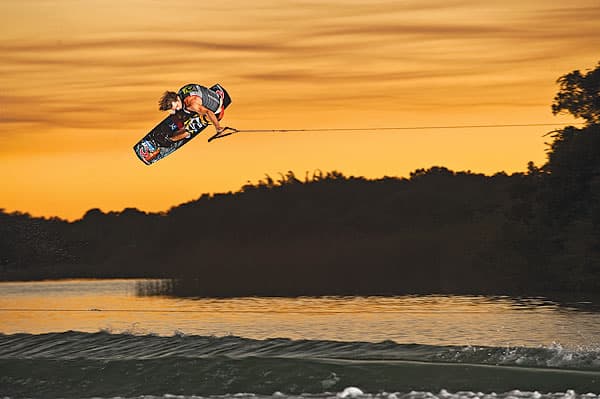
Before Worlds, did you feel like your career was a little underrated? We do, and maybe it’s the media that’s to blame.
I’m not sure. Was it? To date, I am happy with the direction my career has taken. I don’t seek recognition from people, but it is certainly gratifying to hear you stoked someone out or helped someone stick his first toeside air or simply helped get him into the sport. If people feel I’m underrated, then for sure I would take it as a compliment, but for now I’m just going to keep doing what I do!
You seem really positive 100 percent of the time. Why is it so easy for you to keep a good attitude?
I love wakeboarding! I could be a poor sucker sitting in traffic at 6 a.m. on the way to the office, but I’m not! Wakeboarding has given me a lifestyle that I would feel guilty taking for granted. Maybe I would be a little different if I didn’t have wakeboarding, but I don’t see a reason to be anything except positive. Being paid to stand behind a boat is pretty damn cool. As Bruce Robson says, “Could be worse!”
You have always respected your roots and the Aussies who came before you. Why is that so important?
If I had to say what the biggest impact on my career was, I would say the people in my early years. I began riding with some of the most influential people to ever strap on a board, including Reece Jordan (original Double-Up team with Greg Nelson) and Marshall Harrington (originator of off-axis spins). Then I was taken under the wing of Watkins, Sanders and Ike. Other Aussies less known in the United States, like Paul Boyd, also helped keep my head straight, and their outlook on the sport kept me from taking it too seriously. Watkins, Sanders and Ike basically fast-tracked me to where I am. I respect these guys because they helped me shape my career. The old cliché of “I wouldn’t be here without them” often gets thrown around, but if these guys never helped me, I wouldn’t have had anywhere to live in my rookie season. Ike took in myself, Broome and a couple other young grommets for two seasons. We would be snuck into nightclubs, get “rookie slaps” for anything stupid and were basically shown the ropes. Looking back on my rookie season, I don’t think I realized at the time how utterly useless I was! I think Aussie grommets owe a lot to the lads who came before them because they can now simply follow in footsteps rather than start their own to careers in Florida.
Give a quick description of the Hacko as it applies to wakeboarding and what it means to be a rider from there.
The Hacko in southern Sydney, or Port Hacking, is the birthplace of wakeboarding in Australia. It is a river that is synonymous with style, and I guess it is Australia’s equivalent of the West Coast. The riders who came from the Hacko, such as Jordan, Grant “Chief” Gettins, Harrington and Boyd always put emphasis on making sure the trick they were doing was done “right.” I feel lucky to have come from a river with such rich history. It saw the first twin-tip wakeboard shaped and ridden by Jordan and Chief in 1991 called a Cordial. It was a completely finless board resembling today’s flex boards with snowboard bindings that you would use shoes with. It would be the basis for some board shapes 10 years later from mainstream companies. They were developing different rocker patterns, both continuous and three-stage, which wouldn’t really be seen for another few years. Riding with these guys had a huge impact on my riding. I have never been recognized as a “style” rider, but I have always tried to make sure I stick to my roots and do everything right. I think riding with Jordan and Boyd helped my creative side in the sport and brought the fun aspect to my riding. I could go out and be stressed from a long contest weekend, but as soon as I’m back riding with the Hackos, I remember why I started! I came onto the Australian scene in 2000, right around the time the second wave of Hackos came through, including Broome, Amber Wing and my sister Hayley. We would go out riding every afternoon with up to eight people every day. We would ride doubles, see how big we could drive and hit starter-roller triple-ups and live and breathe wakeboarding. I have great memories on the Hacko; it’s home.
You ride the boat and cable really well. Where do you want to improve as a rider?
Definitely on the cable! I have been into riding cable for 18 months now, and I even went to Turkey this year for the Worlds. It sucked that I had a busted ankle from Parks’ Double or Nothing, so I couldn’t really push myself. I like riding cable because there are no expectations of me, so it has become a sort of “serious hobby.” I guess the way I ride behind the boat complements my cable riding, where loading the line is key. There are a lot of cable critics, and I guess I used to be one. I should use this moment to publicly say “you were right” to Mitch Langfield. I used to give him shit for riding at Orlando Watersports Complex all the time, and now I froth on it! It actually helps my boat riding too. I learned switch front mobes on the corner at OWC, then took it to the wake. I have learned a huge portion of my wake tricks from kickers at cable parks.
Wasn’t there a point where you threw in the towel? How did you rebound?
I definitely reached a breaking point where I was convinced I would never make it as a professional. In 2006 I “retired” and went back to uni . It was the culmination of not getting contest results and lack of financial backing. During the semester I was at uni, I had an epiphany and decided I’d made the wrong decision to retire and came back to the sport I love. I’d say it was the biggest turning point of my career. I decided I would get fit and put everything I could into making sure I would succeed. That included my fitness and how I would carry myself as a professional. I used Watkins as my blueprint. I ended up winning the Australian Pro Tour.
I was impressed by the spontaneous shout-out you got at the Wake Awards this year. What was the deal with that?
Yeah, right? Jeff Barton totally caught me of guard! It gets back to what I was saying about how well my World title was received. To look back and see everyone standing and clapping put me back into that Disneyland mode again where I kept thinking, “Is this really happening?” I’ve been friends with JB for my whole career, so it was cool that it came from him.
At this point in your career, what kinds of things inspire you to keep charging?
I have always thought of wakeboarding as an art rather than a sport. It’s a way to express yourself on the water. You can always tell someone’s mood and personality from the way they ride. It is this reason I am always looking for different ways to charge. Having something in your head and translating it onto the water must surely be the reason we all ride. It certainly is for me, anyway. I think that could be the appeal of contests for me, the stoke of stomping a run I mapped out in my head. As long as my body holds up, I don’t see why I would stop charging because my mind is constantly ticking over. Nobody can watch Chris O’Shea ride then look me in the eye and tell me they aren’t inspired to try something. If you aren’t, then you must not have a pulse — or you are riding for different reasons than me.
Dean William Smith
Birth date: Sept. 15, 1984
Height: 5 feet 7 inches
Weight: 157 pounds
Sponsors: Rockstar Energy Drink, Rip Curl, Ronix, Smith, Skull Candy, Urban Rider, Performance Ski & Surf
Rope Length: 85 feet
Boat Speed: 25 mph
Board/Boots: 143 Ronix Mana with size 10 Kai boots
Residence: Sydney, Australia/Orlando, Florida
Education: Halfway to a marketing degree (wakeboarding put it on hold)
Other jobs worked: Underwater ceramics technician (dish washer)
